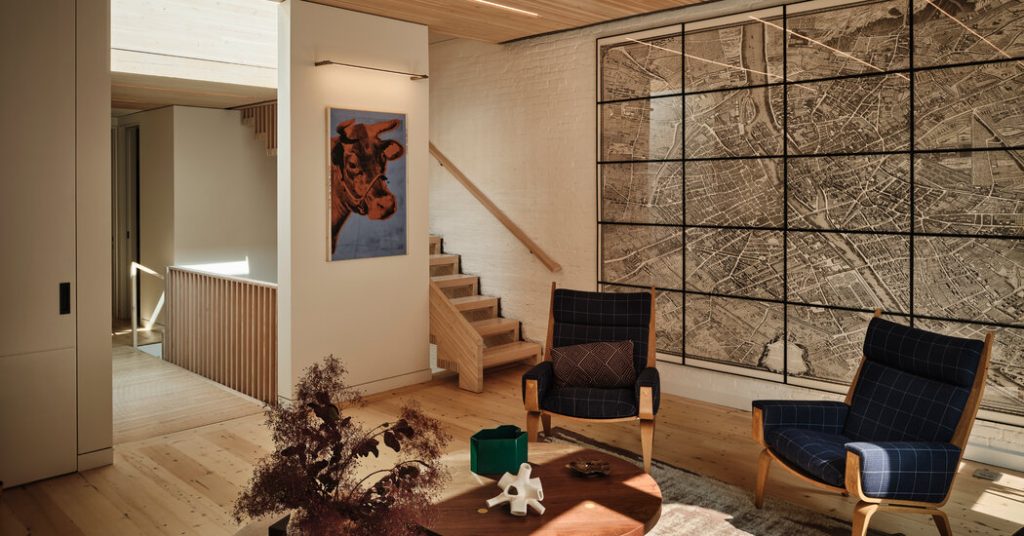One Architect Shows Sustainable Home Renovation Is Possible in Brooklyn
4 min read
When Aaron and Anna Schiller began thinking about building a new home in Brooklyn where they could start a family, Mr. Schiller knew he could use his training as an architect to his advantage.
It was 2017, and housing prices were already soaring. Mr. Schiller, 39, the founder of the architecture firm Schiller Projects, assumed the couple would buy something “that was relatively unattractive to the rest of the market,” so they could get a good deal.
But he had another agenda.
“I was seeking an opportunity to do something I couldn’t find a client to do at that point in time,” he said, “which was to attempt to build, in timber, a near-zero carbon piece of construction.”
Specifically, Mr. Schiller was interested in mass timber construction, which uses engineered wood for structural components — rather than steel or concrete, which are responsible for significant greenhouse-gas emissions.
It took about a year for Mr. Schiller to find his “unattractive” building: an 1870s brick carriage house in Clinton Hill, Brooklyn, that was being used as a limousine garage and apartment.
From the street, the structure was quite handsome. The problems were inside: The rooms were dark and dank, the space was packed full of clutter and the back of the building had been illegally extended, so it needed to be demolished.
When Ms. Schiller, 37, a founder of Planted, a start-up focused on small-scale, modular greenhouses, saw the house, she didn’t immediately share Mr. Schiller’s excitement. “I was, like, ‘Really — this is the space?’” she said.
But with her husband’s enthusiasm and assurance that he could turn it into a beautiful, healthy home, she embraced the challenge. The couple closed on the building for $2.75 million in January 2018.
To transform it, Mr. Schiller stripped the two-story building down to its shell, demolished the back, restored the brick and salvaged the original wood beams so they could be milled into flooring by Tri-Lox, a Brooklyn-based company.
To regain some of the floor area in the back, he designed a small third-story addition and roof deck for the primary suite, which brought the building’s total size to 3,050 square feet.
For natural light, Mr. Schiller introduced a large skylight near the center of the building, directly above an open staircase that functions as a light well. At the bottom of the stairs, he filled a three-foot-deep mechanical pit with soil.
“We planted a six-and-a-half-foot Japanese maple there,” he said. “So there’s a tree growing in the middle of the house.”
To supply the glue-laminated wood panels he needed to build most of the interior, Mr. Schiller found Kalesnikoff, a manufacturer that was producing the material for a large-scale academic building, and convinced the company to produce a little extra for his building, so he could enjoy the economy of scale.
Then he had the prefab home builder Bensonwood use the material to make much of the building off site, including the third-story addition and structural components for the second floor, which contains the living room and two bedrooms for the couple’s daughters, Isabel, now 4, and Frankie, 1.
Once the parts were ready, “the whole thing was put in with a crane and four carpenters, locked into place and waterproofed in seven days,” Mr. Schiller said. “Then they came back later and, in four days, installed the timber stair.”
Although those elements came quickly, Mr. Schiller did encounter Covid-related delays after beginning construction in late 2020. “The lead time for windows and doors went from four to six weeks to 32 to 34 weeks,” he said.
To sidestep that obstacle, he worked with Mattison Millworks, a Brooklyn company, to build custom wood-framed windows and doors, which were completed in about 10 weeks, including monumental floor-to-ceiling sliders on the ground floor that open the kitchen to the backyard.
To reduce energy consumption, the house was aggressively insulated with wood-fiber-based Gutex and hemp insulation, and air sealed. A radiant system provides heat, and an energy recovery ventilator brings in fresh air while helping to maintain interior heat and humidity levels.
The home was finally complete at the beginning of this year for a total cost of about $2 million. Since then, the family has relaxed into living in a space that feels almost as green as a park.
“We’re blessed to have so much light and air in the middle of busy New York,” Mr. Schiller said. “It feels like living in twice as many square feet.”
With so much sunlight, they don’t use the artificial lights as much. “I usually don’t turn on lights until the early evening, because there’s so much natural light that permeates the space,” Ms. Schiller said. “I’ve always wanted to be around nature, so having a tree in our house — and all these materials that are so sustainable — makes it feel like a gorgeous environment.”
And now that the family has moved in, she added, “It’s not a project anymore. It’s a home.”
For weekly email updates on residential real estate news, sign up here.





